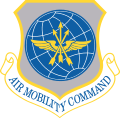9th Air Refueling Squadron  | |
|---|---|
 A Travis KC-10 Extender refuels Navy fighters during a deployment | |
| Active | 1942–1945; 1951–1965; 1969–1982; 1982–present |
| Country | |
| Branch | |
| Role | Aerial refueling |
| Size | over 150 personnel |
| Part of | Air Mobility Command |
| Garrison/HQ | Travis Air Force Base |
| Motto(s) | Universal |
| Engagements | Southwest Pacific Theater China-Burma-India Theater War in Kosovo |
| Decorations | Air Force Meritorious Unit Award Air Force Outstanding Unit Award |
| Commanders | |
| Current Commander | Lieutenant Colonel Andrew Baer[ citation needed ] |
| Current Operations Officer | Lt Col(sel) Barrett Meysembourg[ citation needed ] |
| First Sergeant | MSgt Angelica Asaeli[ citation needed ] |
| Current Squadron Superintendent | CMSgt Gerald James[ citation needed ] |
| Notable commanders | General Arthur J. Lichte General Paul Selva Lieutenant General Michelle D. Johnson |
| Insignia | |
| 9th Air Refueling Squadron emblem [a] [1] [2] |  |
| 9th Air Refueling Squadron emblem [b] [2] |  |
| unofficial 9th Photographic Reconnaissance Squadron emblem (World War II) |  |
| unofficial 9th Photographic Squadron emblem (early World War II) [c] |  |
| Aircraft flown | |
| Tanker | KC-10 Extender |
The 9th Air Refueling Squadron is an active United States Air Force unit, stationed at Travis Air Force Base, California, where it operates the McDonnell Douglas KC-10 Extender as part of the 60th Operations Group.
Contents
- Mission
- History
- World War II
- Strategic Air Command
- Air Mobility Command
- Lineage
- Assignments
- Stations
- Aircraft
- Awards and campaigns
- See also
- References
- Notes
- Bibliography
- External links
The squadron was first active during World War II as the 9th Photographic Reconnaissance Squadron, serving in combat the China-Burma-India Theater from 1942 through 1945, primarily with Lockheed F-4 and F-5 Lightning reconnaissance aircraft.
The 9th Air Refueling Squadron was activated in 1951, and has operated the Boeing KB-29 Superfortress, Boeing KC-97, and Boeing KC-135 Stratotanker, prior to its current air refueling equipment. It has been deployed worldwide, assisting in wartime, humanitarian, and peacekeeping efforts in often remote areas.








